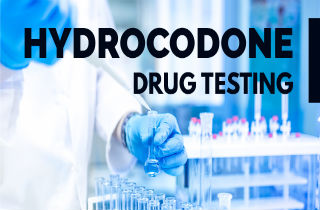Got a drug test coming up for school or work?
Here we review basic information on hydrocodone drug tests including detection times, cutoff levels and the most frequent types of tests used. Please leave us your questions about hydrocodone use or testing below. We respond to all questions and comments personally and if we cannot answer your questions … we will direct you to the help/resources that you need.
Hydrocodone detection
Drugs have certain detection windows, or amounts of time that they are detected in your system after you take them. These detection times are general estimations of ingestion and evidence drug use and usually do not determine amount or chronic use of a drug like hydrocodone.
Furthermore, prescription drugs like hydrocodone are eliminated from the system at different rates and thus detectable for different periods of time, often long after the drug’s effect has worn off. And drug tests differ in their sensitivity. For example, hydrocodone detection time in urine is about 2-4 days (on the safe side), while hydrocodone can be detected in the hair for up to 3 months after your last pill. Most commercial drug tests for hydrocodone, however, detect hydrocodone in the urine for 6-24 hours after last use.
Hydrocodone cutoff levels
Drug testing determines the positive or negative presence of a specified amount of a drug or its metabolite in urine, blood or an alternative specimen. There is a minimum measurement applied to drug testing so that only traces of a drug or its metabolite above a specified level is reported as positive. This measure is known as a “cut-off level,” and it varies for each drug.
Therefore, a drug’s cutoff level or “screening threshold” is the level at which your tester thinks that the substance is in your system. Most cutoff levels are expressed in nanograms per milliliter (ng/ML). In lab test results of 10-panel urine drug screen for the U.S. government, for example, opiates such as hydrocodone have cutoff levels of:
- 2000ng EMIT
- 2000ng GCMS
Types of hydrocodone drug tests
The most frequently used hydrocodone drug test is urinalysis. Current blood or urine tests for hydrocodone only determine whether the drug been used in the last few hours or days.
Positive drug testing for hydrocodone
Several drugs and substances cross react in drug tests for opiates such as NSAIDs efavirenz, chlorpromazine, rifampin, fluoroquinolones, dextromentheorphan or even poppy seeds and quinine in tonic water. These cross reactions can make some drug tests for hydrocodone unreliable. This is why many testing centers screen exclusively for hydrocodone in the urine and have specific procedures for follow up testing. But what can you do if you test positive for hydrocodone and have not been using it recreationally?
Drug screen results are not always clear cut in their interpretation. This is why drug testing centers should use confirmatory tests, especially after an initial positive screen. If an initial screen and confirmation test are both positive, usually a licensed medical doctor who specializes in substance abuse will review your results. It is possible that medical or other reasons may influence your drug test result such as recent surgery, medications or medical discharge.
In fact, doctors should always look for a medically acceptable reason for the result and make clinical determinations on more information than a single test result. Doctors should also not assume that you are abusing hydrocodone, although the addiction potential of Vicodin or other drugs with hydrocodone is relatively high. In many cases, if you are using medications as prescribed, the test may be reported as negative. But in other cases, you may need to contest a false positive test result through a standard protocol.
Hydrocodone drug testing questions
Do you have questions about hydrocodone drug testing? Please leave them below. We’ll be happy to respond to you personally.
Reference sources: Alcohol and Drug Screens: A GUIDE TO THE INTERPRETATION AND EFFECTIVE USE OF SCREENS FOR SUBSTANCES OF ABUSE
Pacific Northwest National Library Article on tests for drug abuse and dependence
State of Virginia information on substance abuse testing









Related Posts